Welcome back! It’s Sunday, and that means a new issue of the Animation Obsessive newsletter. Here’s what we’re doing today:
One — why Hangman is a darkly surreal classic.
Two — the world’s animation news.
Three — the retro ad of the week.
Four — the last word.
We publish our newsletter every Thursday and Sunday. If you sign up to our free list, you can receive our Sunday issues in your inbox every weekend. It only takes a second:
Now, let’s get going!
1. Into our town, the Hangman came
On Twitter, one of our great joys is getting a strong response when we share a film we love that, on the surface, has no business being popular on social media. It always energizes us. It reminds us why we do this.
A while back, that happened with a piece called Hangman. And we’ve still not come down from the high.
Hangman is an American film from around 1964. It’s dark, haunting and mostly devoid of traditional cel animation — it’s a tangle of dissolves and pans across rich, surreal paintings. If you know The Tell-Tale Heart by UPA, Hangman is like that, only pushed even further.
The two films share the same lead artist — Paul Julian. But Hangman isn’t a UPA film, and it doesn’t feel like one. It’s creepier, more alien. That slight air of whimsy from The Tell-Tale Heart is absent here. Hangman is an oppressive piece, and the story it tells isn’t just a weird tale. It adapts a poem from the 1950s about the 1950s, and not the fun parts.
The film was a passion project by one Les Goldman. He’d been active in animation for decades — particularly commercials, serving as a production manager at John Hubley’s studio Storyboard in the ‘50s.1 Hangman was a bit of a departure for him. As Film News reported:
Goldman, who [co-]directed this visualization, heard the poem recited on a folk music radio program in California, found out where he could reach poet Maurice Ogden, raised what funds he could and enlisted the aid of the co-operative artists and craftsmen.
To be specific, it was a show on a Los Angeles station hosted by the DJ Les Claypool. Goldman’s inspired idea to animate Ogden’s poem led to something of a makeshift production. As Goldman’s son later wrote, “My father almost single-handedly raised the money to make the film, with $100 and $200 donations from friends and associates.”2
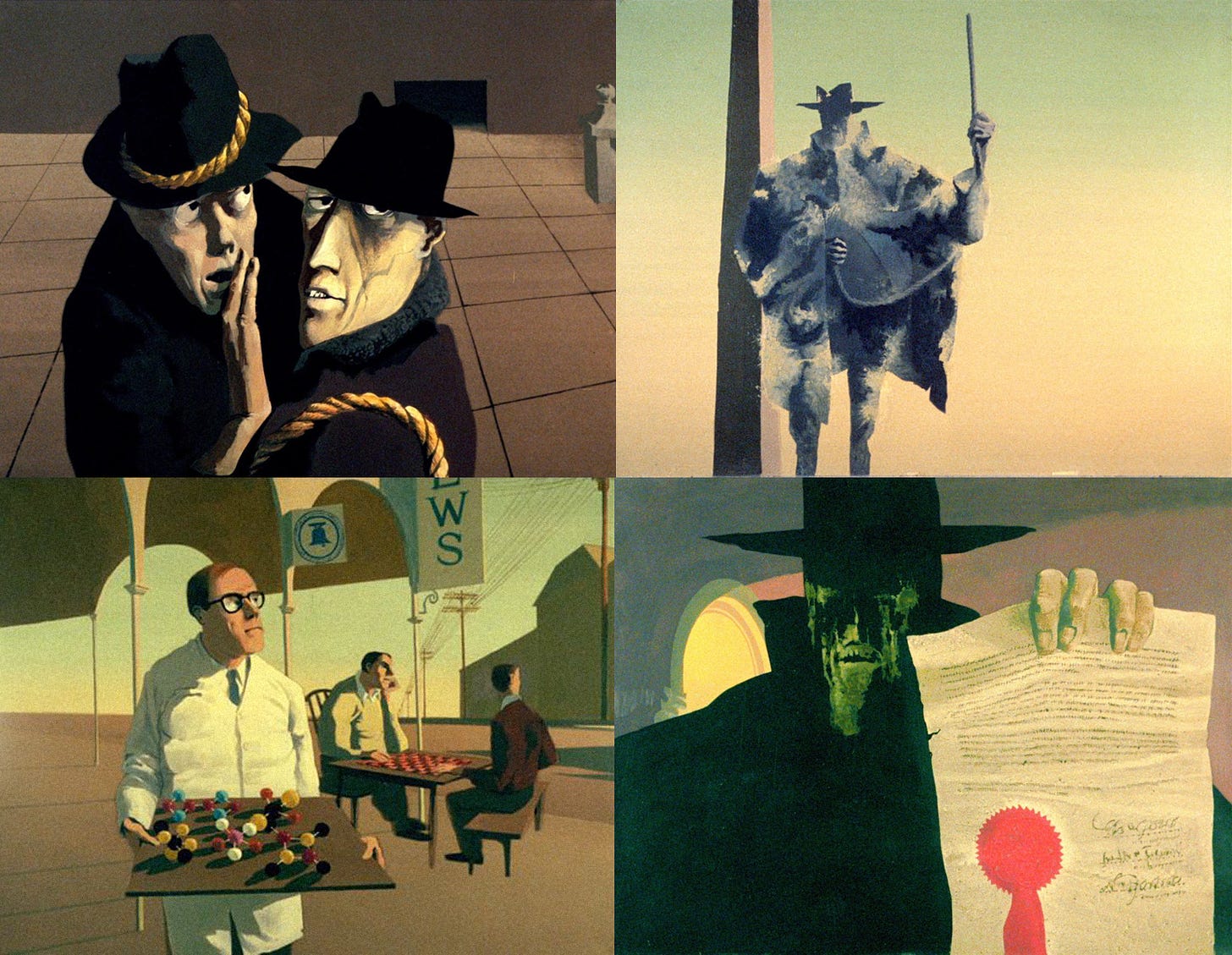
Goldman tapped friends and associates to create Hangman with him, too.
Paul Julian co-directed it, and it might be the most Paul Julian film ever made. His strange, macabre style is all throughout Hangman. “Vigorous de Chirico-like drawings” was how one reviewer described the art. Julian had been playing with this style of animation since UPA’s work on The Four Poster, and that experience shows.
Another Goldman ally on Hangman was Herschel Bernardi, the sole voice in the film. He’s better known for Peter Gunn and for narrating that Tootsie Pop commercial, yet his performance here is something else entirely. It’s been called melodramatic, but we find it thrilling. Bernardi lets his theater background shine, especially when he puts on the Hangman’s gravelly, sinister voice.
It’s not an easy role to sell. The Hangman is a broad symbol, a stand-in for everything from the McCarthyists to the Ku Klux Klan to the Nazis. He murders the marginalized while the rest stand aside, hoping to be spared. As the Hangman’s gallows grows into a hideous tower, though, it’s clear that even cowards won’t be getting out alive.
The message is pointedly progressive, attacking the racism, xenophobia and antisemitism that the silent majority allowed to continue. Goldman himself called Hangman a “morality film.” It was his hope that animation might offer “a new approach to exploring, and hopefully, even remedying some of the human conditions.”
As Goldman’s son later wrote, “Creating this film was one of the most important accomplishments of his life.”
Hangman was shortlisted for the Oscar, but ultimately not nominated. What it did win was an award from the ACLU — for best dramatic film. That was a sign of things to come. Historian Jerry Beck has written that Goldman’s project spread on the education circuit.
In 1972, Film News reported that Hangman had emerged as a “top favorite” in a “recent poll of schools and libraries.” Given how gripping of a watch it is, that’s easy to believe. And, if that burst of Twitter success is any indication, its impact hasn’t waned.
Above, you can see an unrestored copy of the film in full. You might find yourself agreeing, like we do, with the words of one reviewer from 1964: Hangman is “powerful cinema which shocks with its impact and refuses to be dismissed from memory.”
2. News around the world
Barber Westchester is now free to watch
On Saturday, animator Jonni Phillips released her independent feature film Barber Westchester to the public. It’d been exclusive to her Patreon patrons since December 12. Now, it’s available to everyone for free.
We’ve written about Barber a few times already. It’s weird, deeply personal and easily one of the best animated features of the last 12 months. Phillips made almost all of it herself, bringing along friends like Felix Colgrave (Double King, Throat Notes) and Ian Worthington (Bigtop Burger).
Earlier in January, Vulture named Barber one of its most anticipated animated premieres of 2022. And the creators of The Mitchells vs. the Machines raved about it during a promo stunt where Katie Mitchell “took over” the Twitter account of DiscussingFilm. But our favorite praise for Barber is a comment we read this week:
This movie is extremely good and at least for me was the animated equivalent of going to a Rothko exhibit where you think “what.” for about 90 minutes and then “Oh.” for the next several days.
You’ll find Barber on YouTube.
Animators continue to speak out
It’s hard to express just how much union talk there is in American animation right now. The push for a better deal continues to gain speed. In the process, animators are speaking more and more openly about the conditions they’ve faced in the industry. As long as they do, we’ll be documenting it.
A big one this week was Raye Rodriguez, who tweeted about his experience as the creator of High Guardian Spice at Crunchyroll Studios. He explained in a thread that the budget was miniscule and the deadline tight, which damaged the show:
… when we inevitably ran into problems (all productions do), we didn’t have the time or money to slow down and fix them. We had to barrel forward and make do with what we had.
Sofia Alexander, who created Crunchyroll’s Onyx Equinox, supported Rodriguez by writing that the “same thing happened” to her. She recalled the shock of realizing that the budget for Onyx Equinox “was near one-third of a lot of Western shows.” (At the same time, she noted that the studio had its upsides, and that the situation wasn’t “as black and white as it sounds.”)
Elsewhere on Twitter, there was a large discussion over the practice of working unpaid overtime. Steve Lowtwait, an animation veteran from series like Hey Arnold! and Big City Greens, put it like this:
I’ve held the ethic of no unpaid overtime my entire career in animation and never had an issue. Yet I’ve seen co-workers overwork themselves taking on overtime under their own accord in an illusion to prove themselves. Time is not how you prove yourself as a good employee.
Aardman’s blitz
Aardman is revving up. Following the success of Robin Robin, it’s got a new logo — and two big announcements.
The first is that there’s a new Wallace & Gromit film coming in 2024. While they haven’t exactly been absent (see their augmented reality game from last year), it’s been a long time since the duo had a true film. It’s going to tell a story about how “Wallace invents a ‘smart gnome’ that seems to develop a mind of its own.” Outside Britain, this nameless project is set to be a Netflix exclusive.
Then there’s the first look at Chicken Run: Dawn of the Nugget, the sequel to the most successful stop-motion film ever made. It’s due out on Netflix in 2023. Will it be hampered by the fact that almost a quarter of a century has passed since Chicken Run? Maybe. But this is Aardman, whose track record speaks for itself.
Best of the rest
If you don’t work in Hollywood, have you ever wondered what the screenplay to an American animated blockbuster looks like? Well, via Deadline, you can read the complete scripts to both Raya and the Last Dragon and Encanto.
The intriguing Japanese film Pukkulapottas and Hours in the Forest combines time-lapse photography with stop-motion animation. See a trailer.
As Putin’s troops amass on the border to Ukraine, the world of Russian animation continues, eerily, like nothing’s changed at all — a new animation school for kids, boasts of 100% industry growth and festivals seeking entries.
The South African studio Triggerfish (Zog, Revolting Rhymes) seems to have scored a moderate hit on Netflix with its feature film Seal Team.
In America, the four most-streamed films of 2021 were animated, according to Nielsen. Animation also claimed seven of the top ten slots. Animated series, on the other hand, weren’t so lucky — only Cocomelon made the top 15.
Also in America, The Hollywood Reporter has a really insightful interview with Jennifer Lee about running Disney Animation, signing pan-African talent and more.
The Pokémon Company is betting on India. Its YouTube success with the Hindi dub of Pokémon Journeys has led to dubs in Bengali, Telugu and Tamil.
A Taiwanese team has released the “first Hakka 3D animation” — referring to the local ethnic group. It ties into a Hakka tradition, dragon bombing, indigenous to Miaoli County in western Taiwan.
Lastly, a lot of noise has been made lately about animators’ use of automorph in Japan. It’s an impressive trick — Anime News Network has the story.
3. Retro ad of the week
It’s been a while since our last retro ad spotlight. This time, we’re looking at a tiny treasure made at John Hubley’s studio Storyboard. It’s from the mid-1950s.
Hubley was a master of the quick, entertaining sell. Storyboard put out plenty of iconic full-length spots, like Marky Maypo and Speedway Boogie Woogie, but its shorter ads were equally great. Take this commercial for sanforized fabric, for example.
The point of sanforizing fabric is to keep it from shrinking in the wash. Hubley and his team found an ingenious way to portray this in under 20 seconds. A hard rain hits a trio of classical musicians and turns them into a jazz band, complete with small suits and short hair. Not one frame is wasted, and the sell comes almost entirely from the entertainment value. See it below:
4. Last word
That’s a wrap! Thanks for reading — and thank you again to our paying subscribers (members), whose support allows us to do the research we do. Members can expect our next issue on Thursday.
If you missed our previous issue, Spain Through the Eyes of a Ghibli Animator, it looks into the unusual case of Nasu: Summer in Andalusia. Call it a Ghibli film that Ghibli didn’t make. It’s a fascinating mix of elements, and the story behind it involves Hayao Miyazaki, Japan, Spain, pickled eggplant and what it means for one culture to interpret another. Plus, it’s responsible for probably our most controversial tweet ever.
One last thing. Speaking of Twitter, we were pleasantly surprised this week by how many people resonated with the clip we shared of Junk Head, a bizarre cult film from Japan. You can find it here. It’s not quite like any stop-motion animation you’ve watched before.
See you again soon!
From Broadcasting-Telecasting (July 16, 1956). Other key sources for the piece include The Glens Falls Times (November 13, 1968) and Gardena Valley News and Gardena Tribune (March 7, 1965).



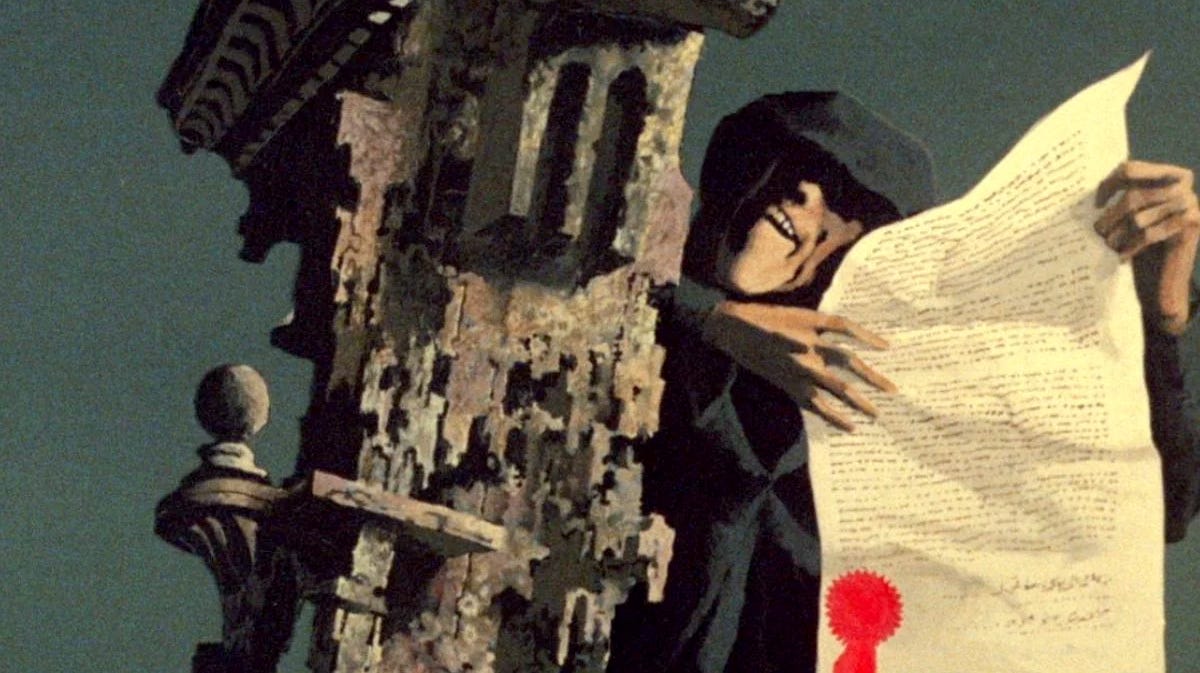
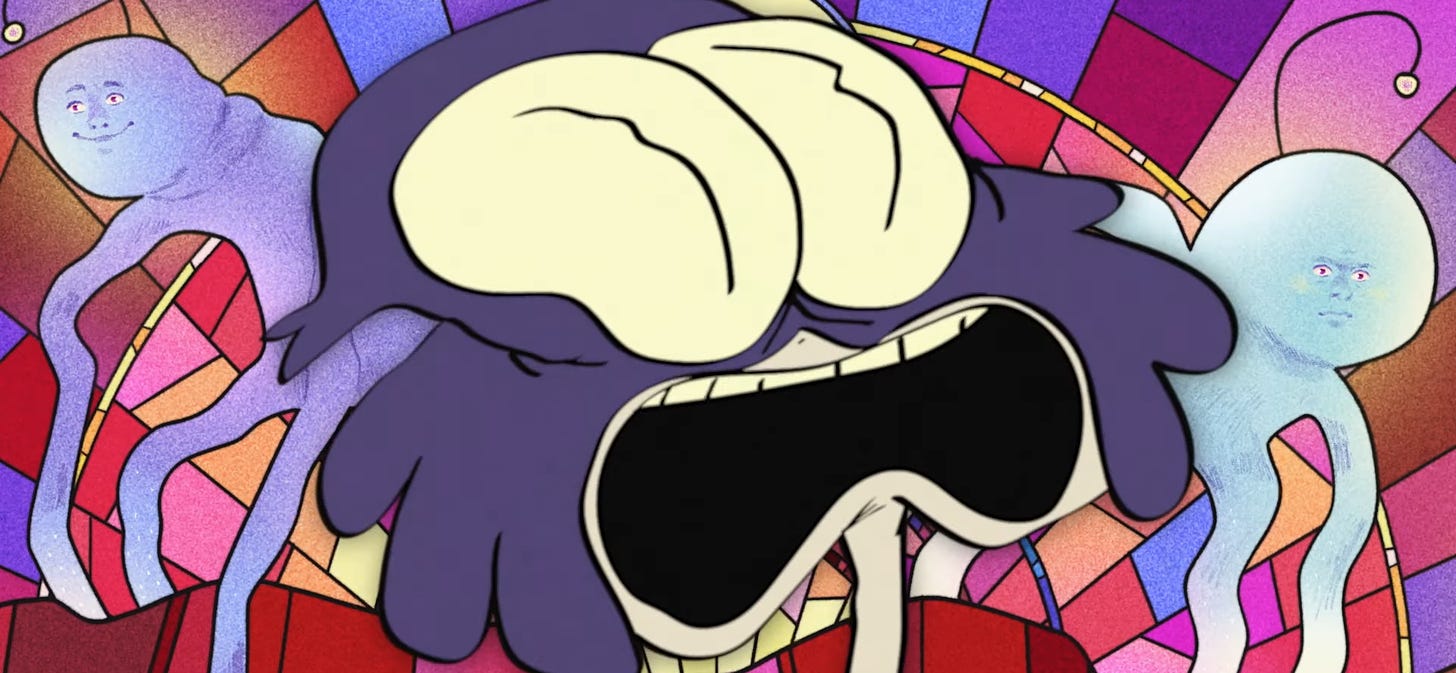
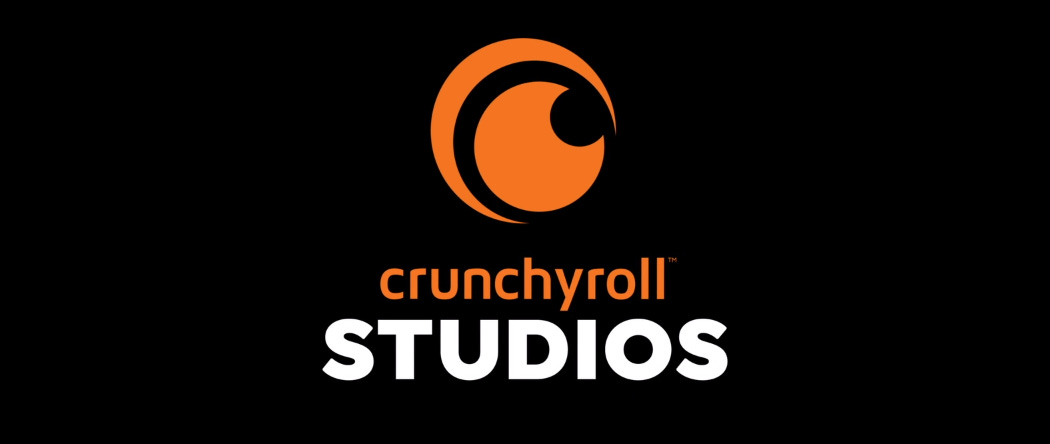
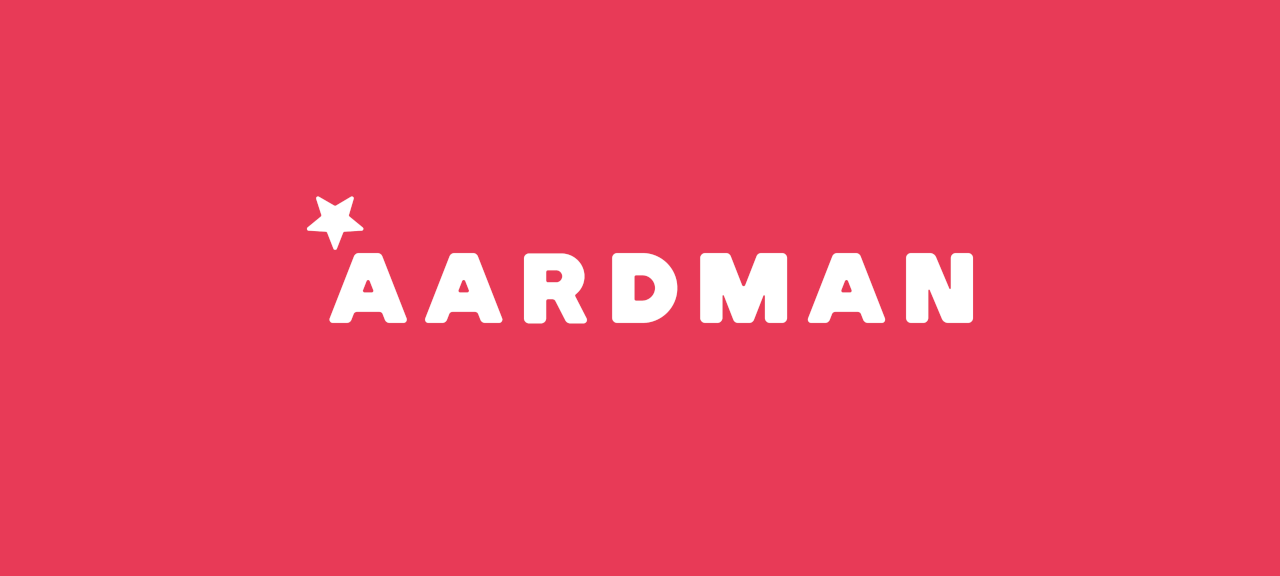
Hangman. Wow. There's actually very little animation in the film, but that "lack" perhaps provides a feeling of increased gravitas. On the other hand I found the music strangely jaunty in ways, though that also felt like a(n appropriately?) grotesque contrast and complement to the story. I won't soon forget the images of the hanged men—quite disturbing. I was unusually thankful for the light-hearted retro ad at the end.